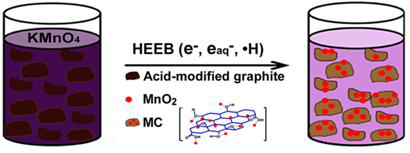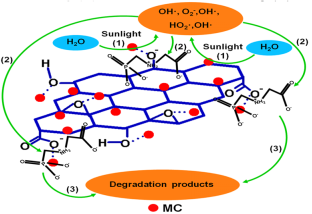
Glyphosate (GP), a kind of non-selective and broad-spectrum synthetic herbicide, is currently widely used for both annual and perennial weeds. The unused GP on crop leaves tends to discharge into environment through rain water washoff, causing severe water contamination due to its high water solubility and mobility properties. The toxicity of GP to human beings is associated with its ability to bind acetylcholinesterase, resulting in neuromuscular paralysis and organ failure. Therefore, it is necessary to effectively decontaminate the GP residue to lower its environmental impact.
Given this, a study team led by Professor WU Zhengyan in Institute of Technical Biology and Agriculture Engineering, developed an alternative MnO2/C composite catalyst based on KMnO4 and graphite using high energy electron beam (HEEB) irradiation. The paper entitled Degradation of Herbicide (Glyphosate) Using Sunlight-sensitive MnO2/C Catalyst Immediately Fabricated by High Energy Electron Beam was published in Chemical Engineering Journal.
In this study, the MnO2/C composite could be obtained by HEEB irradiation at the dosage of 30 kGy with WKMnO4/WC ratio of 50:1. Such irradiation could effectively and facilely reduce MnO4- to MnO2 nanospheres through the reduction effects of e-, eaq-, and ·H, as well as make graphite possess rough surface through thermal and sputtering effects of electron beam.
In addition, HEEB irradiation introduced numerous chemical groups on the surfaces of the MnO2 nanospheres and graphite, which facilitated the binding of MnO2 nanospheres to the HEEB-modified graphite via hydrogen bonds.
The resulting MnO2/C composite possessed a high catalytic degradation efficiency for GP under sunlight due to its nanostructure comprised of high porosity, large specific surface area, and large number of active sites which greatly enhanced the utilization of UV light, and thus, catalytic degradation could be accomplished under sunlight. As a result, 92.05% of the initial GP could be degraded by MC to generate PO43-, H2O and CO2 under sunlight.
This work provides a facile, green, and low cost approach for fabricating catalysts with high degradation efficiency for organophosphate herbicide under sunlight.
This research was supported by National Natural Science Foundation of China and the Chinese Academy of Sciences.

This schematic diagram is showing the fabrication of MC via HEEB irradiation. (Image by WANG Min)

This schematic diagram is showing the GP degradation process by MnO2/C composite. (Image by WANG Min)

86-10-68597521 (day)
86-10-68597289 (night)

86-10-68511095 (day)
86-10-68512458 (night)

cas_en@cas.cn

52 Sanlihe Rd., Xicheng District,
Beijing, China (100864)

